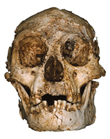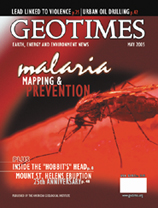
|
Want to write science news? Apply for the Geotimes fall internship! |
||||||||||||||
| |
|||||||||||||||
|
 Inside
the “hobbit’s” head Inside
the “hobbit’s” headBroken bones yield T. rex tissue Meteor Crater's slow impact Falsification alleged at Yucca Mountain NASA on deck Lots of water on Mars Soot from Indian cooking More mercury in unexpected places Early Jupiter spawned early meteorites Oil prices spike Geophenomena
Print Exclusive |
||||||||||||||
|
Lessons from Sumatra Although for most of us, the December tsunami in the Indian Ocean is now a distant event, it still continues to push researchers and policy-makers to examine the risks that natural hazards pose around the world. David Applegate Political Scene Clear Skies Clouded in Legislative Discontent As Congress debates how to regulate air pollutants, recent rules for controlling mercury have come under harsh criticism. Linda Rowan Geologic Column More valuable than gold, or not The metal topping the magnificent Washington Monument is only a few bucks’ worth of aluminum. Lisa A. Rossbacher
|
Michael Collier: Doctor, photographer, geologist Geomedia
|
||||||||||||||
 ON
THE COVER ON
THE COVER Four species of malaria can infect people, causing intense fevers and chills, among other symptoms. Scientists are using advanced models and maps of the disease’s transmission to help prevent the spread of malaria, which kills 1 to 2 million people each year, with more than 90 percent of these deaths occurring in sub-Saharan Africa. Read the story on page 18. Photo is courtesy of WHO/TDR/Stammers. |
June: Geology in the media
|
| SUBSCRIBE | CLASSIFIEDS | ADVERTISE | FOR AUTHORS | CONTACT US | ARCHIVES | SEARCH |
 |
Geotimes Home | AGI Home | Information Services | Geoscience Education | Public Policy | Programs | Publications | Careers |